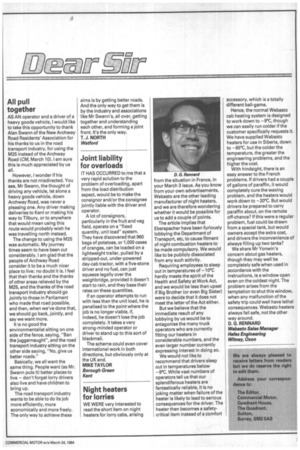Night heaters for lorries
Page 35

If you've noticed an error in this article please click here to report it so we can fix it.
WE WERE very interested to read the short item on night heaters for lorry cabs, arising from the situation in France, in your March 3 issue. As you know from your own advertisements, Webasto are the other leading manufacturer of night heaters, and we are therefore wondering whether it would be possible for us to add a couple of points.
The article implies that Eberspacher have been furiously lobbying the Department of Transport, etc, to cause fitment of night combustion heaters to be made compulsory. We would like to be publicly dissociated from any such activity.
Requiring employees to sleep out in temperatures of —10°C hardly meets the spirit of the Health and Safety at Work Act, and we would be less than upset if Big Brother (or even Big Sister) were to decide that it does not meet the letter of the Act either.
But we believe that the immediate result of any lobbying by us would be to antagonise the many truck operators who are currently fitting our heaters in considerable numbers, and the even larger number currently expressing interest in doing so.
We would not like to recommend that drivers sleep out in temperatures below —9°C. While vast numbers of operators tell us that our splendiferous heaters are fantastically reliable, it is no joking matter when failure of the heater is likely to lead to serious consequences for the driver. The heater then becomes a safetycritical item instead of a comfort accessory, which ls a totally different ball-game.
Hence, the normal Webasto cab heating system is designed to work down to —9°C, though we can easily run colder if the customer specifically requests it. We have supplied Wabasto heaters for use in Siberia, down to —65°C, but the colder the temperature, the greater the engineering problems, and the higher the cost.
With hindsight, there is an easy answer to the French problems. If drivers had a couple of gallons of paraffin, it would completely cure the waxing problem, and the heaters would work down to —20°C. But would drivers be prepared to carry paraffin about, on the remote off-chance? If this were a regular problem, fuel could be drawn from a special tank, but would owners accept the extra cost, and drivers the inconvenience of always filling up two tanks?
We share Mr Yonwin's concern about gas heaters, though they may well be completely safe when used in accordance with the instructions, ie a window open even on the coldest night. The problem arises from the temptation to shut this window, when any malfunction of the safety trip could well have lethal consequences. Webasto heaters always fail safe, not the other way around.
D. G. RENNARD Webasto Sales Manager Hefac Engineering Witney, Oxon
























































































